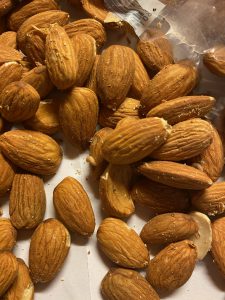Ugh!
Have you ever taken something out of your pantry or cupboard to find the item teeming with pests? I have and it is NOT a good feeling! Recently, I attempted to use raw almonds I had stored in a sealed plastic bag only to discover worms! Yes, worms! Then, upon careful inspection, a few moths! Not only did it ruin my meal plan, it ruined my appetite for almonds!
On the bright side, it forced me to clean out my pantry. I emptied the shelves. I took EVERYTHING out and inspected both the shelving and the food packages/containers. I removed the shelves, vacuumed all the cracks and crevices, washed everything down and used a fan to ensure dry, future pest-free storage. I was lucky; my infestation was limited to a bag of raw almonds purchased a few weeks prior.
However, I learned that almonds could be the harbinger of a moth. And, as you probably know, moths do not actually start out as a moth but as an egg. In nature, the moth lays an egg and the egg hatches to a larva (caterpillar). Upon maturation, the larva forms its pupa (cocoon) and from the pupa emerges the adult moth, only to start the whole cycle over again! Mating and egg laying begin almost immediately after adults emerge from the pupa.
Raw almonds have NOT been heat treated, thus it is pretty common for the product to contain perhaps an element of surprise. (Note: Eating this product with the worm intact hurts nothing other than our psyche!) Although I am certain my moth was an almond moth, the Indianmeal moth has an attraction for the same pheromone (scent). Thus, after buying food, it is extremely important that ALL pantry goods be examined carefully to eliminate the next generation of adults that can fly and contribute to an infestation. EDIS publication EENY-026 Indianmeal Moth is a great publication with pictures of common hiding places. Moths in particular can be found among tree nuts, grains, cereals, spices, herbs, pasta, starches, flour, and even pet foods.
However, pantry pests are not limited to moths. EDIS publication ENY-213 Pantry and Stored Food Pests has pictures and information of the many species of stored food pests found at various times in food pantries. In fact, there is hardly a food item in the kitchen or food pantry that can escape being infested by some pest if it remains unused and exposed in some dark corner or drawer long enough.
To kill insects in infested foods, place food in an oven at 130 degrees F for 30 minutes or in the freezer at 0 degrees F for four days. If freezing, place the food item in a tightly sealed plastic bag to limit condensation on the product, which can lead to mold growth. Defrost the item in the plastic bag and use the product as soon as possible.
During Covid-19, and now hurricane season, consumers have been encouraged to have food on hand for weeks at a time. Now is a good time to take stock of the pantry and learn how to use the FIFO – first in, first out – system of product rotation. FIFO simply encourages prioritization and the use of stored items, so the oldest products are used first.
The presence of stored food pests is not an indication of uncleanliness, since an insect may be brought home in purchased food or on purchased food packages. However, it is important when purchasing any food product, to inspect your purchase to ensure you do not bring home an insect. Even one insect left alone long enough can cause an infestation.
- It’s Chestnut Season! - December 16, 2022
- Persimmons: Food of the Gods - November 23, 2022
- Have You Ever Thought About Entering Baked Goods in the North Florida Fair? - October 28, 2022

